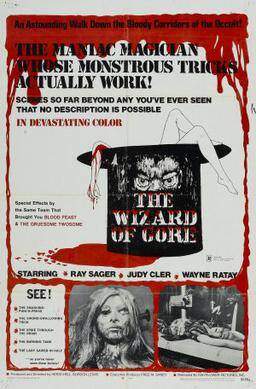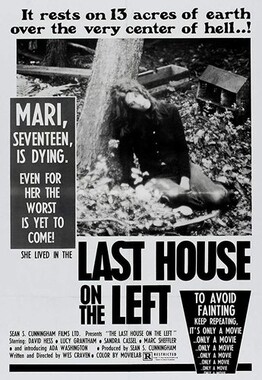10 Killer Chainsaw Horror Movies
Horror movies have given us some of the most menacing and violent on-screen villains since the dawn of cinema, though these masked maniacs are nothing without a trusty weapon with which to do their dirty work. The chainsaw is one of the most iconic weapons in horror next to Michael Myers’ kitchen knife, Jason Voorhees’ machete and Freddy Krueger’s knifed glove, and one particular Ed Gein inspired psychopath is the first to come to mind when this grisly, tree-felling tool is mentioned: Leatherface. Aside from Leatherface, there are probably more chainsaw horror movies than you might think out there.
The chainsaw has no particular style or grace, it is the choice of weapon for when your target must absolutely come to the utmost harm you can possibly befall them. It won’t just cut, it’ll carve, grind and mangle. Think you can hide indoors? Those doors better not be made of wood, or whoever’s wielding that snarling, toothed engine won’t be held back for long. Even the most hyperviolent video games aren’t complete without allowing their players to wield the chainsaw, with titles such as DOOM, Gears of War, Manhunt, Left 4 Dead and a good amount of other zombie games on the market including the weapon. That being said, the first exposure most audiences had to the flesh-ripping nature of the chainsaw was through film, so please enjoy the most heinous, violent and barbaric depictions of on-screen chainsaw violence in history.
The Wizard of Gore (1970)

Herschell Gordon Lewis’ The Wizard of Gore is arguably one of the first horror movies to bring a chainsaw to proceedings, and this early 70s forerunner to post-9/11 torture porn does so with gusto. Deranged magician Montag the Magnificent (Ray Sager) invites women onto his stage show where he performs grisly illusions upon them, usually by dismembering them in some way, before having them return to their seats magically unharmed. Later, when the women begin dying for real in ways identical to their ‘deaths’ on stage, people begin to suspect there is more to Montag than simple magician’s tricks. Featuring plenty of over the top gore and an ending likely to confuse as much as it does enthral, fans of classic cult horrors should take note.
The Last House on The Left (1972)

Wes Craven, who would later carve his own legacy in the annals of American Horror, first directed a harrowing and highly sexualised revenge horror in 1972. Other than a previous adult film, this was Craven’s directorial debut and it is clear he was out to shock from the start. Later re-releases dub The Last House on The Left as “The Original Chainsaw Massacre”, though the weapon is not actually featured until the film’s final act. Rather than wince when the snarling saw is finally brandished, however, audiences will shout encouragement at its wielder as he sets it upon the man who raped and killed his daughter. This shock revenge flick has as satisfying an ending as any that came after it, and the loud, intense edge of the chainsaw is partly to thank for that.
The Texas Chainsaw Massacre (1974)

This is the big one, folks. Directed by Tobe Hooper and unleashed to shock unsuspecting audiences around the globe in 1974, Texas Chainsaw is not only the ultimate exercise in chainsaw-based carnage, but still remains one of the most unsettling and intense horror movies to this day. Advertised and being based on a true story it was all too real for some audience members. With a whole family of antagonists including the instantly recognizable, Ed Gein-inspired Leatherface, Hooper’s classic brings a specific flavor of nastiness that is often imitated, though never quite perfected.
Motel Hell (1980)

Kevin Connor’s 80s black comedy/horror centers around siblings Vincent and Ida Smith (Rory Calhoun & Nancy Parsons) who run a motel along with a food stand selling their world famous sausages. After some investigation it is revealed that the origin of their meat surplus has a gruesome connection to the disappearance of a few guests, and farmer Vincent must do everything he can to protect their secret. Featuring darkly comical gore, lively performances all round and the pig-masked Vincent brandishing a huge chainsaw, this early 80’s cult classic is perfect for those who want a good laugh with their gore.
The Evil Dead (1981)

The Evil Dead might not have been the first use of the chainsaw in horror history, though it is easily one of the most recognizable. It is used by protagonist Ash Williams to cut off his own possessed hand in Evil Dead 2 (1987), before he fits the tool to his dismembered stump as a gruesome prosthetic, making it all the easier to hack through the forces of darkness. It was also used to great effect in reboot Evil Dead (2013) where it is shoved down the antichrist’s throat mid-blood rain in one of the most insane climax shots ever. While the chainsaw would later become Ash’s signature in the later films, it was first introduced in the original The Evil Dead (1981) when Ash tries to slice his beloved Linda in half and can’t bring himself to, opting to bury her instead, which goes as well as one would expect.
Pieces (1982)

Pieces is about as campy and scattershot an affair as one would expect from an early 80’s slasher. A group of college co-eds in Boston are stalked by a mysterious killer wielding a chainsaw, who steals body parts from each victim for a bloody jigsaw puzzle. Like many of its era, Pieces displays gratuitous gore, even more gratuitous nudity and a knowing edge that stops it from taking itself too seriously. What it also includes, however, are many absurd and almost random scenes that seemingly have no purpose other than to divert from an otherwise very standard and conventional plot. It is an absolute mess of a movie, but maybe that’s just your kind of thing.
American Psycho (2000)

Directed by Mary Harron and adapted from Bret Easton Ellis’s 1991 novel of the same name, American Psycho is a humorous, horrifying and intriguing look at the life of Patrick Bateman (Christian Bale). Bateman, a wealthy investment banker from New York, is also a serial killer who moves from departing the homeless, to colleagues who annoy him, and then to random members of the public, seemingly unable to contain his psychotic urges. The film employs plenty of good humor alongside its visceral brutality, playing with the fragile ego of the unreliable narrator Bateman on such subjects as music, sex and even the business cards of his fellow bankers. One particularly harrowing scene shows Bateman chasing a prostitute around his apartment complex, completely naked and brandishing a chainsaw. As his victim descends the spiral staircase to escape, Bateman smugly allows the chainsaw to fall towards her rather than chasing her himself. The energy and menace Bale brings to his role is enough to make any lumberjack look twice at his trusted power saw.
Tokyo Gore Police (2008)

Next up is a fantastic Japanese splatter action directed by Yoshihiro Nishimura which features, true to its name, buckets of blood and guts along with some truly bizarre weapons and mutations. Think Power Rangers but with more cybernetic body modification and gore-soaked mayhem than you can shake a severed tendon at. Rather than anyone running the the woodshed for their trusty tree-feller, the creatures that vengeful police officer Ruka (Eihi Shiina) must fight have the things coming from every orifice of their mutated bodies! Like some overblown cyberpunk nightmare, TGP comes through with some of the weirdest gore-based spectacle on offer. With raving critical and audience reviews, this serves as a perfect introduction to Japan’s infinitely obscure splatter scene, and gore movies in general, keeping things funny, interesting and completely unexpected until the final frame.
Dead Snow (2009)

If there’s one thing more morally fogiveable than killing Nazis, it’s killing zombies. This 2009 Norwegian horror/comedy combines the two, along with a healthy splattering of references to the greats (Evil Dead mainly), for an end result which is as hilarious as it is gruesome. Naturally, a homage to Raimi’s classic would have been nothing without that famous buzzing blade being used to dismember a few fascist undead, and director Tommy Wirkola took great pleasure in crafting an epic battle scene between our chainsaw-wielding heroes and a horde of the rotting horrors on a snowy mountain plane. The scene in question could be placed with the likes of the famous lawnmower scene in Peter Jackson’s Braindead (1992) as one of the most fun pieces of brutal mass-killing to watch on screen. Be sure to also check out the sequel.
Mandy (2018)

In terms of 80’s soaked grindhouse violence, Mandy has everything. A revenge plot from the deepest fever dream of the cinema obsessed Panos Cosmatos, Mandy serves to scratch an itch for all lovers of overblown gore and gut-wrenching storytelling. And if these fanatics are anything like me, then near the top of their list of hopeful scenes is the conceptually legendary, yet criminally underused, chainsaw fight. Cosmatos didn’t only decide to craft one of the greatest face-offs in recent memory, but was so proud of it that he included it on the film’s cover art. This kind of boldness and confidence is what draws me to projects such as these, and I for one am waiting with bated breath for whatever darkness Cosmatos casts over us next.
Chainsaws in Horror Movies
Well that’s a wrap on some must see chainsaw wielding maniacs. If you need more you can always dig into the iconic Texas Chainsaw Massacre franchise, makes for a nice binge weekend if you can stomach it. With that said we are promised a new film from the franchise in 2022. Will you be there with proper ear and eye protection as we witness the revival of Leatherface?
Joe first knew he wanted to write in year six after plaguing his teacher’s dreams with a harrowing story of World War prisoners and an insidious ‘book of the dead’. Clearly infatuated with horror, and wearing his influences on his sleeve, he dabbled in some smaller pieces before starting work on his condensed sci-fi epic, System Reset in 2013.Once this was published he began work on many smaller horror stories and poems in bid to harness and connect with his own fears and passions and build on his craft.
Joe is obsessed with atmosphere and aesthetic, big concepts and even bigger senses of scale, feeding on cosmic horror of the deep sea and vastness of space and the emotions these can invoke. His main fixes within the dark arts include horror films, extreme metal music and the bleakest of poetry and science fiction literature.
He holds a deep respect for plot, creative flow and the context of art, and hopes to forge deeper connections between them around filmmakers dabbling in the dark and macabre.
